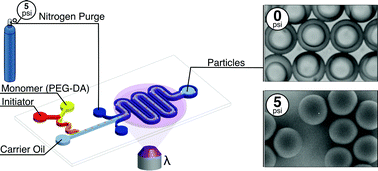Monodisperse polyethylene glycol diacrylate hydrogel microsphere formation by oxygen-controlled photopolymerization in a microfluidic device†
Abstract
PEG-based hydrogels have become widely used as drug delivery and tissue scaffolding materials. Common among PEG hydrogel-forming polymers are photopolymerizable acrylates such as polyethylene glycol diacrylate (PEGDA). Microfluidics and microfabrication technologies have recently enabled the miniaturization of PEGDA structures, thus enabling many possible applications for nano- and micro- structured hydrogels. The presence of oxygen, however, dramatically inhibits the photopolymerization of PEGDA, which in turn frustrates hydrogel formation in environments of persistently high oxygen concentration. Using PEGDA that has been emulsified in fluorocarbon oil via microfluidic flow focusing within polydimethylsiloxane (PDMS) devices, we show that polymerization is completely inhibited below critical droplet diameters. By developing an integrated model incorporating reaction kinetics and oxygen diffusion, we demonstrate that the critical droplet diameter is largely determined by the oxygen transport rate, which is dictated by the oxygen saturation concentration of the continuous oil phase. To overcome this fundamental limitation, we present a nitrogen micro-jacketed microfluidic device to reduce oxygen within the droplet, enabling the continuous on-chip photopolymerization of microscale PEGDA particles.


 Please wait while we load your content...
Please wait while we load your content...